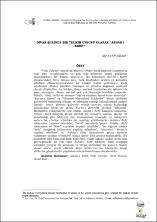Divan şiirinde bir telmih unsuru olarak “Ashâb-ı Kehf”
Künye
Ayan Nizam E. (2013). Divan şiirinde bir telmih unsuru olarak “Ashâb-ı Kehf”. Turkish Studies (Elektronik), 8(13), 483-499.Özet
"Yedi Uyurlar" olarak da bilinen Ashâb-ı Kehf hikâyesi İslamiyet'in yanı sıra Hristiyanlık'ta ve pek çok kültürde çeşitli şekillerde anlatılagelmiş bir hikâye olmuştur. Bu hikâyenin Kur'ân-ı Kerim kıssalarından birisi olması onu, halk tarafından sevilen ve kutsallık atfedilen efsanevî/menkabevi bir hikâye hâline getirmiştir. Halk tarafından Allah'a yürekten inanışın ve yeniden doğuşun sembolü olarak düşünülen bu hikâye, divan şairleri tarafından da işlenen bir konu olmuştur. Divan şairleri pek çok kaynağa telmihler yaparlar. Telmih; "dinî, tarihî ve efsanevi kişi ve olaylara işaret etme sanatıdır". "Kur'ân-ı Kerim" ve "Efsanevi-Menkabevi Hikâyeler" divan edebiyatı şairlerinin beslenmiş olduğu ve telmihler yaptığı kaynaklardan sadece ikisidir. Divan şiirinde şairlerin telmih unsuru olarak kullandığı konulardan birisi de gerek Kur'ân-ı Kerim'de gerekse "EfsaneviMenkabevi Hikâyeler"de söz edilen Ashâb-ı Kehf hikâyesi olmuştur. Ashâb-ı Kehf hikâyesi divan şiirinde bir mesnevi konusu olarak ele alınabildiği gibi hikâyeyi bize anımsatmak amacıyla bu hikâyenin sadece bir yönüne telmihler de yapıldığı görülmüştür. Ashâb-ı Kehf hikâyesine yapılan telmihler; "Kehf" suresinde geçen Ashâb-ı Kehf hikâyesine ve "Kehf" suresine yapılan telmihler", "bir sığınak olarak "kehf" (mağara) kelimesine yapılan telmihler", "köpekleri "Kıtmir"e yapılan telmihler" ve "Ashâb-ı Kehf hikâyesinde geçen kişilerin isimlerine yapılan telmihler" olmak üzere dört grupta toplanabilir. Bu makalede dinî-tasavvufî halk hikâyeleri içinde olduğu kadar divan şiiri geleneğimizde de yeri olan Ashâb-ı Kehf hikâyesi ifade ettiğimiz telmihler yoluyla ele alınacak ve divan şiirimizde bu konuya telmih yapan şairler tespit edilerek divan şairlerinin bu hikâyenin hangi yönlerine göndermeler yaptıkları ortaya konulmaya çalışılacaktır Ashâb-ı Kehf which is also known as “Yedi Uyurlar” (Seven Sleepers) is a story which has been told in different religious cultures including Islam and Christianity. The story is among the fables in Quran, making it a liked, divine and mythical story. People think that it is a symbol of faith in God and rebirth. The story has also been covered by divan poets. Divan poets make use of reference to various entities. Reference in this context refers to the art of making references to religious, historical and mythical people and events. Of these sources Quran and mythical stories are dominant. Ashâb-ı Kehf is one of such mythical strories due to its unique characteristics mentioned above. The story is covered as a mesnevi topic as a whole and also, as a part in divan poetry. The related references to the Ashâb-ı Kehf stroy can be categorized under four headings: the references to the story and Kehf sura, those to the word Kehf itself which means “cave”, thse to the dog called Kıtmir in the story and those to the people in the story. The study analyses references made to the Ashâb-ı Kehf story and identifies which divan poet made such references. In addition, the devices used by the poets in making these references are also determined in the study


















